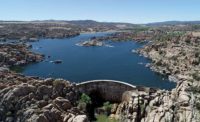Saturation divers, working one at a time, have begun a repair project on a pumped-storage hydroelectric system at Horse Mesa Dam on the Salt River in central Arizona. The repair will reestablish 115 megawatts of peak-load generating capacity that was lost 13 months ago, when failure of a guide vane sent about 50 tons of concrete shooting down the penstock serving the turbines.
"It is our largest hydro-generation asset on the Salt River," says Roger Baker, principal engineer for hydro-generation at the U. S. Bureau of Reclamation's Salt River Project, which owns and maintains the facility. He says getting it back into service is "critical."
Baker says the incident occurred at the remote dam, about 65 miles northeast of Phoenix, just as the turbines were powering up to support rising midday demand. Operators heard a series of loud bangs and immediately shut down the system. Investigation showed a large piece of debris had passed through the steel penstock and come to rest in the turbine scroll. Fortunately, the dam itself was unharmed. Crews hauled the material out by hand through a 34-in.-dia access door.
"The operators described it as a dump-truck load of rocks coming down the penstock," says Baker. "The cause is still under investigation."
Horse Mesa Dam was finished in 1927 as a conventional water-storage and 32-MW generating facility. In 1972, it was modified by Bechtel with a "pumpback" system. The design uses electricity during non-peak hours to pump water from downstream back into the 245,138-acre-ft Apache Lake reservoir for reuse during peak-load periods. The modifications, including the addition of a new intake and guide vanes, was done by conventional construction in a partially drained lake.
However, due to increased pressure on water resources, draining the lake is not feasible now.
Baker says the contractor, Global Diving & Salvage, Seattle, elected to tackle the job using saturation divers. When they are not working in pairs from a diving bell 160 ft below, the divers avoid time-consuming decompression routines by living at the surface in pressurized, helium-rich quarters for a month.
The contractor started early this year with the task of moving 29 tractor-trailer loads—including the barge that supports the effort as well as housing, boats and other facilities—to the remote site. The loads had to travel 30 miles of twisting two-lane roads, ending in six miles of dirt road snaking through the canyon .






Post a comment to this article
Report Abusive Comment